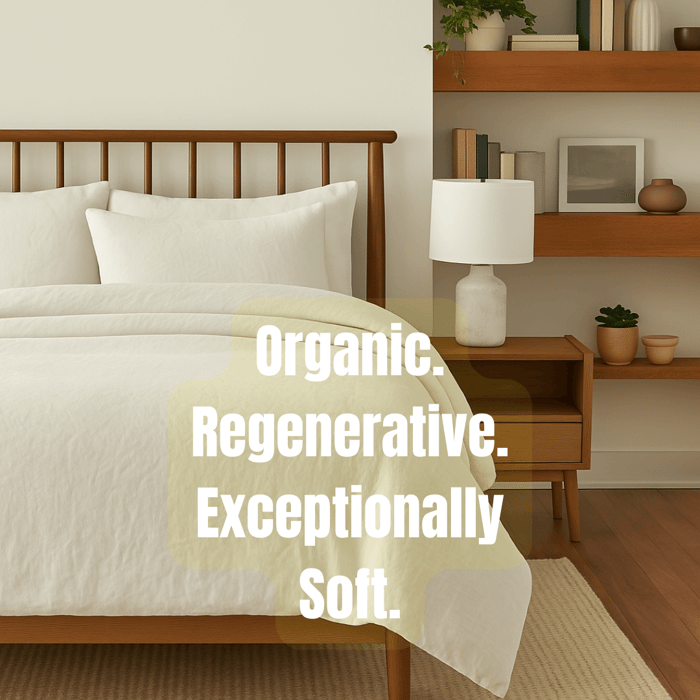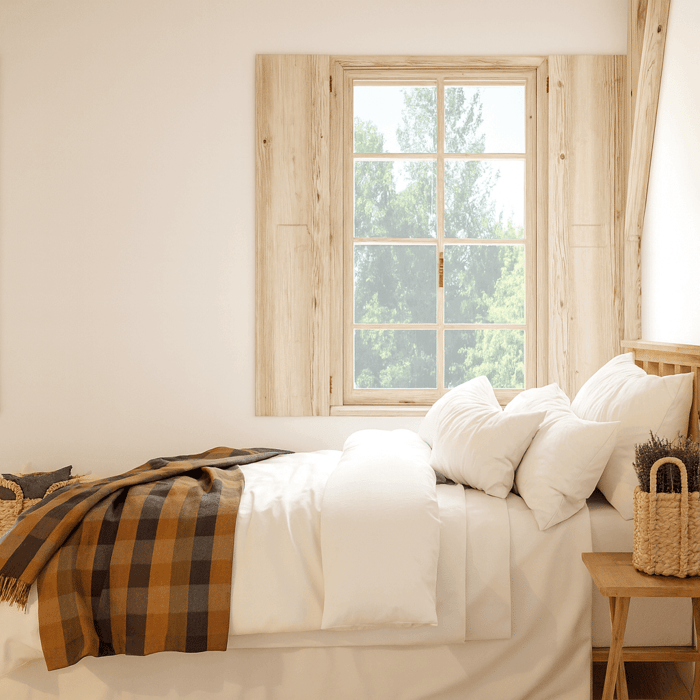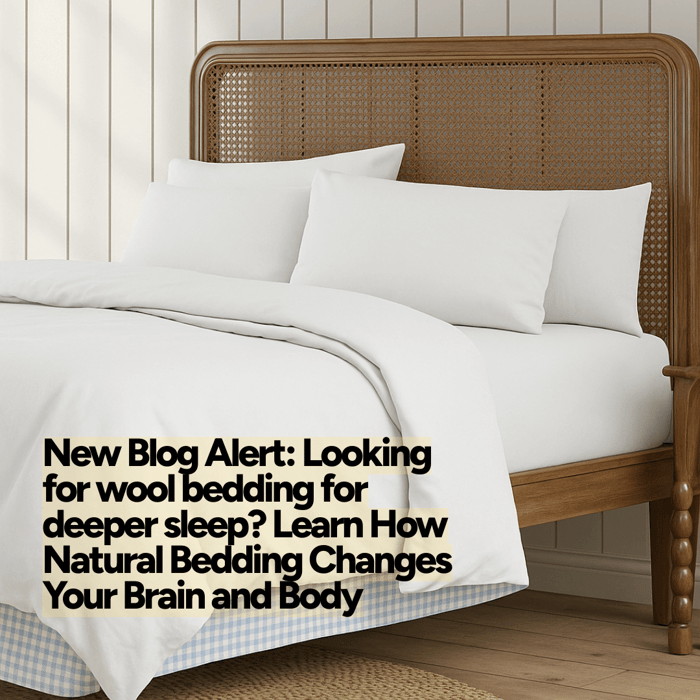Table of Contents
Sustainability isn’t a label — it’s a lifecycle. We’ve been trained to look for one word on a comforter tag — organic — and call it a day. But what if that’s just the start? A truly sustainable comforter goes far beyond the material itself. It begins in the soil and ends with how it returns to it. And along the way, it should support ecosystems, farmers, and your health — not just tick a box.
If you’re shopping for an eco friendly wool comforter, here’s the deeper story you deserve to hear.
Organic Wool Comforter | Made in New Zealand, Breathable All-Season Comfort

$342.00
$380.00
Sleep naturally better with our organic wool comforter Unlike down or synthetic comforters that trap heat, our spun wool design wicks away moisture and prevents overheating, so you stay cool & dry. Designed for deeper sleep with a gentle weight… Read more
The 5 Stages of Sustainability (And Why Most Brands Don’t Talk About Them)
Most sustainable comforters on the market might highlight recycled plastic fill or “organic cotton,” but what’s missing is the full lifecycle. A sustainable comforter should excel at all five stages:
Raw Material Sourcing
Manufacturing & Processing
Distribution & Packaging
Product Use & Longevity
End-of-Life Disposal or Regeneration
Let’s break each one down — and explain why regenerative wool is in a league of its own.
Comforter vs. Duvet vs. Duvet Insert — What’s the Difference?
Shopping for bedding can get confusing fast. Some brands say comforter, others say duvet, and then you’ll see the term duvet insert thrown in too. Here’s what each really means:
Comforter: A quilted blanket filled with insulating material (wool, down, or synthetic). It’s designed to be used on its own without a cover. Comforters are often stitched to keep the fill in place and are meant to be your top layer.
Duvet Insert: Essentially the same concept as a comforter, but made to go inside a duvet cover. On its own it looks like a plain, often white, filled blanket. With the cover added, you can easily change colors, styles, or wash the cover separately.
Duvet Set: When you buy a duvet insert together with its matching cover (sometimes with pillow shams as well), that’s a duvet set. It’s the most practical option for people who want both the performance of wool and the flexibility of an easily washable cover.
In short:
- A comforter = ready-to-use, no cover needed.
- A duvet insert = fill-only, goes inside a cover.
- A duvet set = insert + cover bundled together.
👉 At Antipodean Home, our sustainable comforter is designed for people who love simplicity, while our wool duvet set includes a removable organic cotton cover — perfect if you like to refresh your bedding look or want easy washability.
Raw Material: Regenerative Wool vs. the Rest
Conventional Wool: Often raised in large-scale operations with chemical dewormers, synthetic feed, and overgrazed land. It’s better than polyester, but not ideal.
Recycled Fill (like rPET): Made from plastic bottles — which sounds good until you consider the microplastics, energy-intensive processing, and eventual landfill fate.
Organic Cotton: Grown without pesticides, but can still deplete soil and require massive water use. Doesn’t insulate or regulate temperature like wool.
Regenerative Wool: Comes from farms actively rebuilding soil, increasing biodiversity, sequestering carbon, and grazing animals humanely. This is the only fill that gives more to the land than it takes.
✅ Winner: Regenerative Wool — It’s not just less harmful. It’s healing.
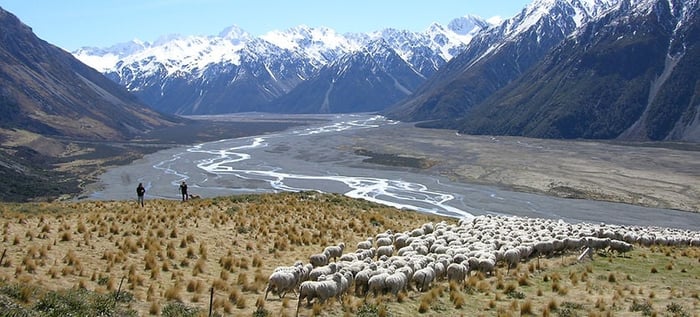 Regenerative Wool Farming | Antipodean Home | Made in New Zealand
Regenerative Wool Farming | Antipodean Home | Made in New Zealand
 Regenerative Wool Farming | Antipodean Home | Made in New Zealand
Regenerative Wool Farming | Antipodean Home | Made in New ZealandRegenerative Wool vs. Organic Wool vs. Alpaca vs. Down vs. Bamboo
When you’re shopping for an eco-friendly duvet or sustainable comforter, you’ll see plenty of claims: organic, bamboo, alpaca, down. Here’s how they truly compare:
Regenerative Wool
Raised on farms that rebuild soil, increase biodiversity, and sequester carbon. Naturally breathable, moisture-wicking, and temperature-balancing — it keeps you cool in summer and warm in winter. It’s the only fill that restores the land it comes from, not just avoids harm.
Organic Wool
Produced without synthetic pesticides or chemicals. It’s safer and cleaner than conventional wool, but doesn’t always address soil regeneration or carbon drawdown. A strong choice, but regenerative wool goes further.
Alpaca Wool
Known for softness and warmth, alpaca duvets feel lighter than sheep’s wool. Many people compare alpaca vs wool duvets for luxury feel and breathability. The trade-off? Alpaca has less loft and bounce than merino wool, and sustainable certification is less standardized.
Down
Lightweight and insulating, down comforters are prized for their warmth. But they trap heat and moisture, making them a poor match for hot sleepers. They also raise animal-welfare concerns unless responsibly sourced. Down doesn’t manage sweat like wool, so you may overheat.
Bamboo
Marketed as a “cooling” option, bamboo fill or bamboo-derived viscose often involves heavy chemical processing. While bamboo grows quickly and requires little water, the end product is rarely as natural as it sounds. Bamboo duvets can feel silky but don’t regulate temperature as effectively as wool and may rely on blends with synthetics.
Bottom line:
For the most sustainable and breathable option, choose regenerative or merino wool duvets.
Alpaca offers luxury warmth but less resilience.
Down provides loft, but isn’t ideal for hot sleepers or sustainability.
Bamboo sounds eco-friendly but often hides chemical processing and weaker performance.
👉 That’s why we use regenerative New Zealand wool: it performs better for your sleep and for the planet.
| Feature | Regenerative Wool Duvet | Alpaca Duvet | Down Comforter | Bamboo Duvet | Synthetic Fill Duvet |
|---|---|---|---|---|---|
| Temperature Control | Adapts to body & climate — cool in summer, warm in winter | Very warm, lighter weight but less adaptive | Warm but often traps heat | Cooling feel at first, but less effective long-term | Traps heat, little breathability |
| Moisture Management | Absorbs & releases up to 30% of weight in moisture | Good at wicking, but less than wool | Absorbs but holds moisture — can feel damp | Limited moisture control (depends on blend) | Doesn’t absorb moisture — leads to sweating |
| Breathability | High — crimped fibers allow airflow | Moderate — lighter but less springy than wool | Moderate — loft can smother airflow | Moderate — silky feel but not as breathable as wool | Low — tends to trap body heat |
| Allergy-Friendly | Naturally hypoallergenic, dust-mite resistant | Hypoallergenic, less lanolin than sheep’s wool | Can trigger allergies unless treated | Marketed hypoallergenic but often processed | Not hypoallergenic, attracts dust mites |
| Durability | 10–15 years with care | 7–10 years, less loft resilience | 5–10 years | 3–5 years, weaker fibers after washes | 3–5 years before flattening |
| Sustainability | Regenerative farming, biodegradable, compostable | Often eco-friendly but less standardized certification | Animal welfare concerns, non-biodegradable | Bamboo grows fast but often chemically processed | Fossil-fuel derived, sheds microplastics |
| Best For | Year-round use, hot sleepers, eco-conscious buyers | Luxury warmth, lighter feel, cold sleepers | Cold climates, people who like loft & fluff | Shoppers wanting a “cooling” option but not true sustainability | Budget shoppers, short-term bedding |
Manufacturing: Clean, Chemical-Free, and Local
Many so-called sustainable comforters are bathed in softeners, whiteners, or flame retardants that undo their eco benefits. Even natural fills can be treated with chemical resins to prevent clumping.
At Antipodean Home, we do things differently:
Our wool is peroxide-whitened (never bleached with chlorine).
We skip optical brighteners and formaldehyde-based finishes.
Our comforters are assembled close to the source in New Zealand, reducing transit emissions.
When evaluating a sustainable comforter, always ask: How was it treated? And how far did it travel?
Packaging & Distribution: Less Air, More Ethics
Most bedding is compressed into plastic and shipped across oceans in bulk — often with mystery materials and no traceability.
We package our sustainable comforters in breathable cotton bags, not plastic wrap. We ship using carbon-conscious logistics partners and offset our emissions where we can.It’s not perfect. But it’s intentional.
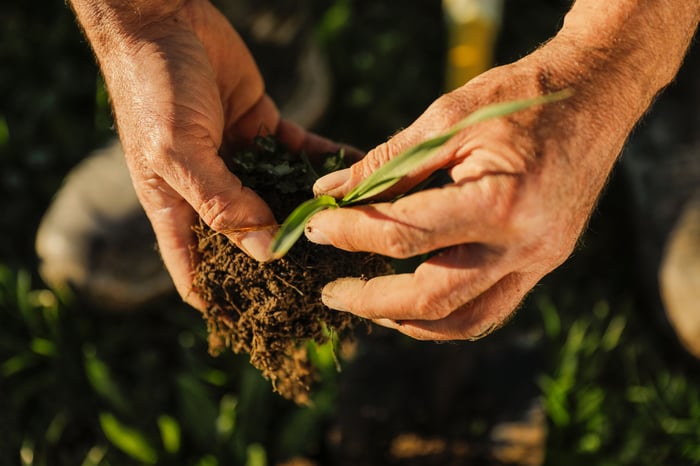 Regenerative farming promotes healthy soil | Antipodean Home | Made in New Zealand
Regenerative farming promotes healthy soil | Antipodean Home | Made in New ZealandIn Use: Performance Matters
A sustainable comforter shouldn’t just be green on paper — it should help you sleep better for years to come.
Wool is naturally:
Temperature-regulating
Moisture-wicking
Hypoallergenic
Mildew- and dust mite-resistant
Our Airlay method spins the wool into springy balls that retain loft and airflow — meaning no clumping, no flattening, and no tossing off the covers at 2am. This means you can use the same comforter year-round — no seasonal swapping needed.
That’s not just convenient. That’s sustainable design.
Best Wool Duvet for Hot Sleepers and Night Sweats
The best sustainable comforter isn’t just eco-friendly — it performs better for sleep too. So if you run warm at night, you already know the struggle: waking up sweaty, tossing off the covers, or flipping your pillow to the “cool side.” The right duvet can make all the difference.
Why wool works for hot sleepers:
- Breathable by design – Wool fibers have a natural crimp that creates tiny air pockets, allowing heat to escape instead of getting trapped.
- Moisture-wicking – Wool can absorb up to 30% of its weight in moisture without feeling damp, pulling sweat away from your body so you stay dry.
- Temperature regulating – Unlike synthetics or down, wool responds to your body heat and the room climate, keeping you cool when it’s warm and cozy when it’s cold.
Our lightweight wool duvet inserts are especially good for hot sleepers because the Airlay design allows maximum airflow between the fibers. Instead of clumping or flattening, the wool stays springy and breathable, giving you year-round comfort.
👉 If you’re searching for the best wool duvet for night sweats or overheating, regenerative wool is a natural solution: it balances temperature, manages moisture, and helps you sleep deeper without waking up drenched.
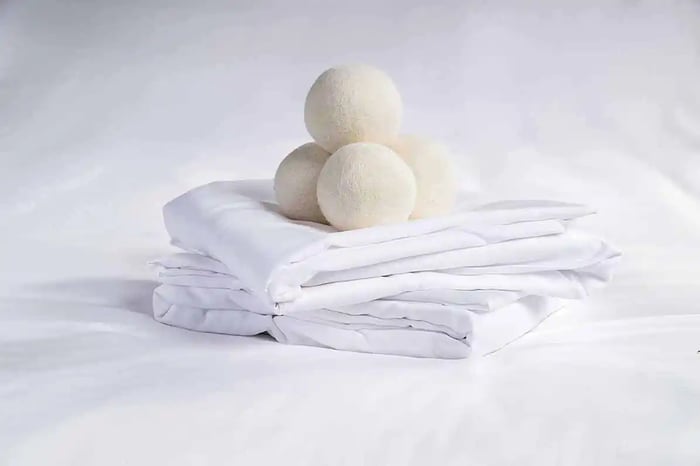 Organic Cotton Sheets | Antipodean Home | Made in New Zealand
Organic Cotton Sheets | Antipodean Home | Made in New ZealandEnd of Life: Compost Over Landfill
Here’s the dirty truth: most "eco" comforters still end up in the trash.
Why? Because they’re blends of natural and synthetic materials, chemically treated, or impossible to separate.
Our wool comforters are 100% biodegradable — no poly fill, no mystery foam. Even the stitching is thoughtfully selected so that it can return to the earth.
When its journey with you is done, it doesn’t become waste. It becomes nutrients.How to Wash and Care for a Wool Duvet or Comforter
One of the most common questions is “How do I wash a wool duvet?” The good news: caring for wool is simple — and easier on the planet than you might think.
General care tips:
- Regular airing: Hang your duvet outside in fresh air or sunlight every few weeks. Wool naturally refreshes itself and resists odors.
- Spot cleaning: If you spill, blot the area with a mild soap solution and let it air dry.
- Cover first: Always use a duvet cover. It protects the wool insert from dust and reduces how often you need to clean it.
Washing guidance:
- Wool inserts are not designed for frequent machine washing.
- Do not put a wool duvet in a tumble dryer — high heat can shrink and damage fibers.
- To refresh, air-dry the duvet flat or on a line.
- If a deep clean is needed, choose eco-friendly dry cleaning or professional wool care services.
👉 With simple care, your organic wool duvet insert or comforter stays fresh and performs beautifully for years.
Wool Duvet Durability — How Long Should It Last?
A true test of sustainability is longevity. So how long does a wool duvet or comforter last?
- Average lifespan: With proper care, expect 10–15 years of comfortable use — far longer than most synthetic comforters, which often flatten within 3–5 years.
- Why it lasts longer: Wool fibers are naturally springy, resilient, and resistant to clumping. The Airlay design we use helps maintain loft and airflow.
- Sustainability bonus: Because wool duvets last longer, you buy less often — lowering your long-term cost and environmental footprint.
👉 In short, a regenerative wool duvet is an investment in comfort and value: it saves money over time, performs better for longer, and returns to the earth at the end of its life.
What to Ask Before You Buy a Sustainable Comforter
If you want to be a conscious consumer (without a degree in textile science), here are five quick questions to ask:
What is the fill, and how was it farmed?
Were harsh chemicals used in processing?
Where was it made, and by whom?
Can it be used year-round?
Can it return to the earth when I’m done?
If a brand can’t answer those clearly — that’s your answer.
Sustainable Comforter Certifications to Look For
Not all “eco-friendly” claims are equal. Certifications help you separate genuine sustainability from clever marketing. When choosing a wool duvet or sustainable comforter, look for these trusted standards:
- ZQ Certified Wool – Guarantees animal welfare, land stewardship, and traceability from farm to finished product.
- GOTS (Global Organic Textile Standard) – Covers the entire supply chain for organic fibers, ensuring no harmful chemicals are used in processing.
- OEKO-TEX® Standard 100 – Tests every component of the product (fabric, thread, buttons) to ensure it’s free from toxic substances.
These labels prove more than comfort — they prove your duvet has been made with respect for people, animals, and the planet. At Antipodean Home, our regenerative wool duvets go beyond organic by actively restoring ecosystems while meeting international safety and sustainability standards.
Where to Buy Sustainable Wool Duvets (and Why Origin Matters)
Location matters more than most shoppers realize. A wool duvet made in New Zealand has a very different story than one shipped from overseas factories. Here’s why origin counts:
- New Zealand Wool – Globally recognized for purity, softness, and ethical farming. Our regenerative farms manage over 3.7 million acres of land.
- Closer to Source – Bedding assembled near the farms reduces unnecessary transport emissions.
- Transparency – Sourcing from countries with strong environmental and animal welfare standards ensures quality and trust.
And what about regional searches? Whether you’re looking for a wool duvet in the USA, a wool duvet in Canada, or a New Zealand wool duvet shipped worldwide, knowing the origin helps you compare products honestly.
👉 When you choose a regenerative New Zealand wool duvet, you’re not just buying bedding. You’re supporting farms that give back to the land — and getting a product that performs better, lasts longer, and ships responsibly.
Why Regenerative Wool Is the Future of Sustainable Bedding
We believe regenerative wool is the gold standard. It checks every box:
Ethical animal welfare
Soil health and carbon drawdown
Local, low-impact production
Naturally high-performance sleep
Circular design and compostability
At Antipodean Home, our sustainable comforters are more than soft — they’re smart. Each one is a genuinely eco friendly wool comforter, made from the land, for the planet, and built to restore it.
Because truly sustainable bedding doesn’t just support your sleep. It supports life.
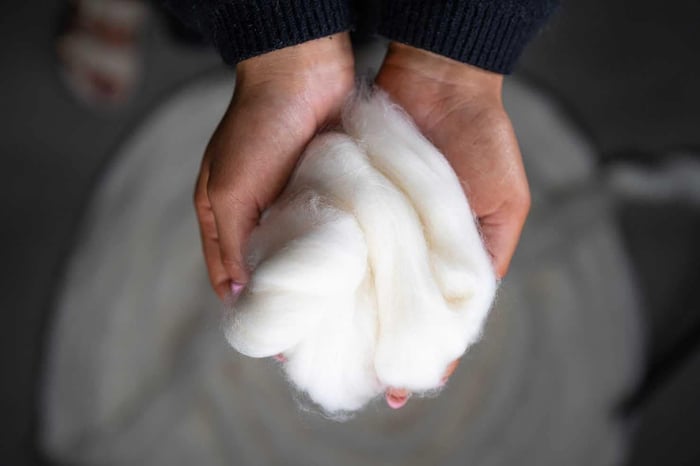 Regenerative Wool | Antipodean Home | Made in New Zealand
Regenerative Wool | Antipodean Home | Made in New ZealandWool Duvets vs. Synthetic & Down Alternatives: Choosing a Sustainable Comforter
When choosing bedding, most people compare wool duvets with either synthetic fills or down comforters. The differences are clear:
- Synthetic Fills (polyester, microfiber): Affordable and lightweight, but they trap heat and moisture. Synthetics are prone to clumping, flatten quickly, and can harbor dust mites. They’re also derived from fossil fuels and release microplastics when washed.
- Down: Known for loft and warmth, down duvets can feel luxurious — but they often trap too much heat, making them uncomfortable for hot sleepers. Down also absorbs moisture without releasing it, leading to clamminess. Ethical concerns remain around sourcing unless certified.
- Wool: Naturally temperature-regulating and moisture-wicking. Wool duvets adapt to your body and environment, keeping you cool in summer and cozy in winter. Unlike synthetics or down, wool is fully biodegradable and actively supports regenerative farming.
👉 For balanced comfort and sustainability, wool duvets outperform both synthetic and down alternatives.
Why New Zealand Wool Sets the Global Standard
When it comes to wool, not all sources are equal. New Zealand wool is recognized worldwide for its quality, purity, and ethical production. Here’s why it stands out:
- Climate & Pasture: New Zealand’s temperate climate and open pastures produce long, strong, and naturally white wool fibers that spin into durable, soft bedding.
- Animal Welfare: Strict standards ensure sheep are raised humanely, with no mulesing and high-quality care.
- Environmental Leadership: New Zealand is home to pioneering regenerative farming programs, including ZQRX, which restores ecosystems and sequesters carbon.
- Traceability: From farm to finished product, supply chains are transparent and certified.
Whether you’re shopping for a New Zealand wool duvet, comforter, or duvet set, you’re getting bedding that performs beautifully, lasts longer, and supports a farming culture rooted in respect for nature.
👉 That’s why at Antipodean Home, we work exclusively with regenerative New Zealand wool — setting a higher global standard for sustainable bedding.
Want to sleep sustainably? Explore our collection of eco friendly wool comforters made with regenerative materials and no compromises.
FAQs on Wool Duvet Inserts, Comforters & Sustainable Bedding
What makes a comforter truly sustainable?
A sustainable comforter is one that’s eco-friendly from start to finish — not just in the material. That means responsibly farmed fibers (like regenerative wool), clean chemical-free processing, minimal packaging, long-lasting durability, and a biodegradable end of life.
Is a wool duvet or sustainable comforter good for hot sleepers?
Yes. Wool is naturally temperature-regulating and moisture-wicking, which makes it one of the best choices for hot sleepers or people who struggle with night sweats. Unlike down or synthetic fills, a sustainable wool comforter adapts to your body heat and keeps you comfortable year-round.
How do you wash a wool duvet or sustainable comforter?
The easiest way to care for a wool duvet is to use a removable cover and air it out regularly. Spot clean if needed, but avoid machine washing or dryers, as heat and agitation can damage the fibers. For a deeper clean, choose professional wool care or eco dry cleaning.
Do wool duvets or sustainable comforters have a smell?
New wool can carry a faint natural scent from lanolin, the waxy coating on wool fibers. This usually fades quickly with use and airing. A light natural smell is a sign of authenticity — and far safer than chemical odors from synthetics.
How long should a sustainable comforter last?
With proper care, a high-quality wool duvet or sustainable comforter can last 10–15 years. Its resilience means you won’t have to replace it as often as synthetic or down bedding, saving you money while reducing waste.

